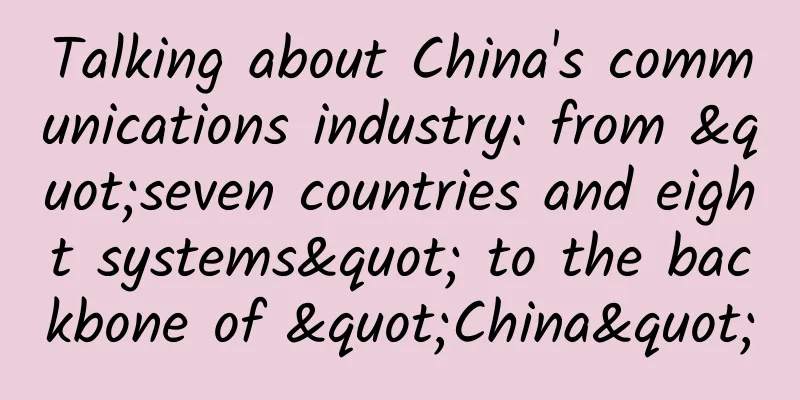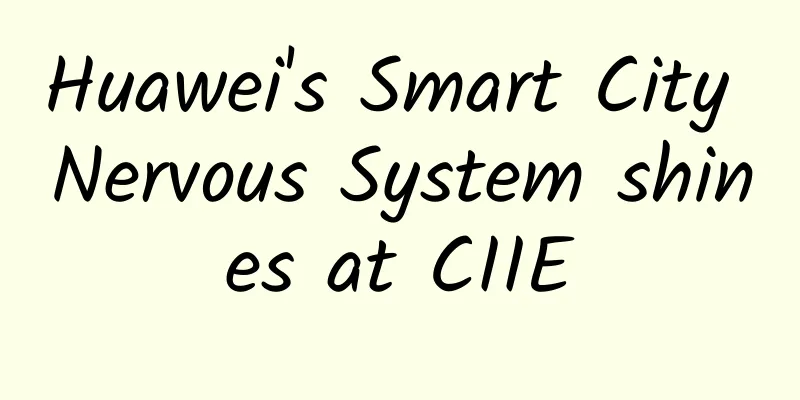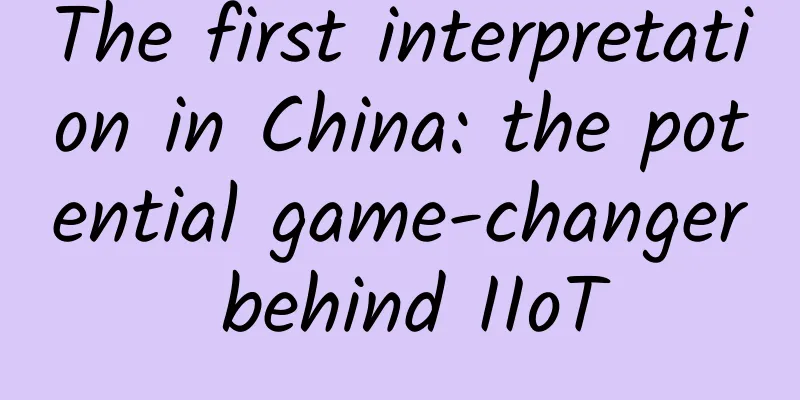Talking about China's communications industry: from "seven countries and eight systems" to the backbone of "China"

|
Salute to China's communications industry, Huawei and ZTE In this article, I will talk to you about the communications industry I have worked in. Recently, there has been an influx of information from all aspects, including chatting with classmates from Huawei, and I have indeed felt a lot. I majored in communications engineering in my undergraduate studies and information and communications engineering in my graduate studies. I have learned the history and professional courses of communications since my undergraduate studies. Later, after being recruited by a communications company, I was also influenced by some communications culture and feelings. Well, let's talk about it! In fact, from the current point in time, China's communications industry is actually doing quite well, at least in the 5G era. Our communications industry has gone through decades of development and change. Many people may not know much about the development process along the way and the stories of generations of communications people catching up and surpassing, which is what will be explained below. The era of “seven countries and eight systems” Speaking of Chinese communications, the earliest era is of course the fixed-line era, which is also the era of program-controlled switches as described in the textbooks of communications engineering. Because during this period, all communications equipment used in China relied on imports, after all, the key core technologies were controlled by developed countries such as the United States, Europe and Japan. Therefore, in the 1980s, a popular concept in the communications industry was "seven countries and eight systems", which means that there were eight types of models or networks from seven countries in our market, namely: Japan's NEC and Fujitsu, the United States' Lucent, Canada's Nortel, Sweden's Ericsson, Germany's Siemens, Belgium's BTM and France's Alcatel, while ZTE and Huawei were companies that were not established in Shenzhen until the mid-to-late 1980s. Today, our parents should still remember how prestigious it was to have a telephone at home in the 1980s and 1990s, because installing a landline would cost thousands or even tens of thousands of yuan. The reason was that all communication equipment at that time was imported, and with high installation costs and communication charges, owning a home landline was a very luxurious thing. This situation continued until 1990, when my country's first digital switch, the ZX500, developed by ZTE, was launched, gradually breaking the Western technological monopoly and barriers. I remember that I attended the company's training after I joined the company after the campus recruitment, and I also heard some interesting things. For example, on a communication device we bought from someone, a piece of iron plate was broken and needed to be replaced, and we had to pay dozens of dollars to them. When bidding abroad, our Chinese communication company made all kinds of exquisite PPT films to explain to customers the business, technology and services that our Chinese communication company can provide, while Ericsson's PPT film was only one or two pages, and the only PPT film showed a world map and the map was filled with small red flags representing their products... This is the era when our communications industry is being divided! Blank and follow [1G/2G era] 1G and 2G can be said to be basically dominated by Motorola and Ericsson The so-called 1G era is what we call the "big brother era", which took place in the late 1980s and early 1990s. The so-called 1G communication actually used analog communication technology, and the communication rate was very low. During this era, our mobile communication industry was almost in a blank stage. It was not until November 1987 that Guangdong opened the first mobile communication network in the country, and the brick-sized mobile call terminal, also known as the "big brother", appeared in the Chinese mainland market for the first time. It was not until 2001 that China Mobile launched the analog network transfer across the country and officially closed the 1G analog mobile phone network. Then, it was almost 2007 when we entered the new 2G digital communication era. Then some people may ask: From the opening of the 1G era in 1987 to the opening of the 2G era in 2007, there was a gap of 20 years? Didn't the products have any iterations? That's because there were various transitional products and stages between 1G and 2G, including but not limited to pagers around 1998, IC phones around 2002, and PHS around 2004. There are two main communication protocols in the 2G era, namely Europe's GSM and the United States' CMDA, and the communication rate is about tens of kbps. Therefore, in the 2G era, only Europe and the United States were competing for supremacy. Of course, China in this era also began to follow the pace of the world trend. It is worth mentioning that the most famous communication giants of this era are Nokia and Ericsson, which started in Europe. In just ten years, Nokia became the world's largest communication equipment manufacturer. I don't know if you still remember that almost all mobile phones on the streets were Nokia phones... Three major players [3G era] 3G refers to the third generation of mobile communication technology. Compared with the first generation 1G analog communication and the second generation 2G digital communication, the third generation has more stable and faster transmission, and diversified services are gradually emerging. In the 3G era, images and music can be transmitted "relatively" quickly, but it is mainly a picture era. The speed is not actually fast, with a rate between 144Kbps-2Mbps. In the 3G era, Europe, the United States, and China were fighting each other. Did you notice that China gradually began to participate in the formulation of standards and achieved breakthroughs? Europe's WCDMA, the United States' CDMA 2000, and China's TD-SCDMA became the three main 3G standards. Of course, the most important technology in the 3G era is CDMA, which Qualcomm holds a technical patent. CDMA has shown great advantages with its large system capacity, high frequency utilization, strong anti-interference ability, and soft capacity and soft switching. At the end of 2008, our country began to issue 3G licenses, but 3G terminals were not widely used until around 2010. At that time, we only used mobile phones to chat on QQ, send texts and pictures. I remember that when I was an undergraduate, everyone used Nokia N series slider phones. Of course, Android phones were also gradually becoming popular, such as Motorola's Defy phone. At that time, the most advanced 3G phone should be the iPhone 3GS released by Apple in 2009. Of course, in the 3G era, China's communications industry also began to make breakthroughs. The three major operators all began to exert their strength. In 2009, China issued three 3G licenses, namely China Mobile's TD-SCDMA, China Unicom's W-CDMA and China Telecom's CDMA 2000. Among them, China Unicom, which obtained the first license (WCDMA is the most widely used in the 3G era), also has the potential to surpass China Mobile in the 3G era. Parallel pursuit [4G era] This is also the time for China's communications industry and equipment manufacturers to achieve parity and parallel with foreign countries. In 2014, we entered the 4G era, which was dominated by LTE. Thanks to the large scale of the Chinese market, the three major operators (China Mobile, China Unicom, and China Telecom) have vigorously promoted the 4G era and built the world's largest 4G network. Moreover, the promotion speed of 4G is very fast, and its popularity is also very high. Before we have waited for a long time and brewed, we have already used 4G equipment and terminals. Of course, in addition to 4G, there is also 4G+. 4G+ is a new generation of 4G network, which can be said to be an upgraded version of 4G network. The peak network speed has been greatly improved. The peak downlink speed of 4G+ is 300Mbps, and the peak uplink speed can reach 50Mbps. 4G+ is the mainstream stage we are in now, and our mainstream mobile phones support 4G+. Leading the Era [5G is coming] Since 2018, the era of the Internet of Everything, created by a series of keywords such as artificial intelligence, virtual reality, big video, and the Internet of Things, has basically begun. ZTE and Huawei have built and passed several 5G networks in several experimental bureaus, and 5G terminals have also been unveiled one after another (although the price of 5G terminals has reached an average of five figures). At this time, I can't help but think of a joke on the Internet: "Ah, in the 5G era, will you go bankrupt if you forget to turn off your mobile phone network at night?" This also vividly illustrates the high speed of 5G communication from the side, which is many times faster than 4G communication. When it comes to 5G, ZTE and Huawei are still very competitive. They are also the two major Chinese equipment manufacturers that can compete head-on with the outside world and lead the world. They are very motivated. So to sum up the development of China's telecommunications industry over the past 30 years, we have experienced a glorious journey of 1G blank, 2G follow-up, 3G breakthrough, 4G parallel, and 5G leading. It is still very remarkable and worthy of pride! Characteristics of the communications industry When people hear Huawei and ZTE, they think of mobile phones. Every time there is news, they buy Huawei phones when they see everyone shouting in support of Huawei. It should be said that mobile phones are really just one aspect of ZTE and Huawei's business. At best, they can only be regarded as a small part of the terminal business, and this is only the business for ordinary consumers. Compared with mobile phones, Huawei and ZTE have many very large business systems. The services and solutions provided to enterprise customers and operator customers are too numerous to mention, including: access network, bearer network, core network, optical communication, multimedia, cloud computing, virtualization, and even a series of products and services involving special industries such as energy. In addition, communication equipment and products are actually a highly integrated entity, involving a very long industrial chain. Companies such as Huawei and ZTE have no way to avoid the long industrial chain and dependence on various parties. This must be a situation of sustainable win-win cooperation. Tesla's innovation is amazing, but many models in the Model series have always had insufficient production capacity. Why? Because they rely on others; Samsung's empire is extremely powerful, but without ARM's authorization, some chip manufacturing may be affected; even Apple, which is in its heyday, has its advantages concentrated on the design of operating systems, ecological chains and complete products. It is estimated that its business will be hindered if some partners are removed. There are too many examples of sustainable development that can only be achieved through global cooperation, and this is just one example. Like the ZTE incident, those who were talking nonsense there were probably unprofessionals or even people who had never worked in the communications industry. After all, no high-tech company can achieve full coverage of upstream and downstream links, so we still have to look at this matter objectively and impartially. Advice for newcomers to the communications industry Many people ask me questions like: What is the telecommunications industry like? Is it a sunset industry? I have signed contracts with ZTE or Huawei, should I go? I am afraid I will regret it, etc. I think that the telecommunications industry has just passed its explosive growth period, but it is definitely not a sunset industry. At least 5G is very promising. People think too much. In addition, from the perspective of the development of the entire communications industry, Huawei and ZTE's performance in the fierce domestic and international competition environment is obvious to all, and Huawei and ZTE are also the only two companies in the world that can provide "end-to-end" solutions. Looking at the international market, where are the giants such as Bell, Nortel, Alcatel, Lucent, Motorola, Siemens, etc.? From a global perspective, there are only a few giant multinational companies in the communications industry, such as Huawei, Nokia, Ericsson, and ZTE. In addition, the telecommunications companies are very good at technology development, and you can definitely learn a lot, whether it is business, technology, or standardized processes and specifications. Even if it is not good, Huawei and ZTE are also very good springboards, right? If you have made a choice, don't think too much, work hard, and you will definitely have your own future! |
<<: Ovum's view: 5G is here, but 4G technology will continue to play a long-term role
Recommend
Will 5G base stations emit more radiation than 4G base stations? I finally figured it out
Despite repeated popularization of knowledge, man...
Leading products and fast delivery: H3C helps Jomtel Mexico cope with digital challenges
Currently, in the digital trend sweeping the worl...
SiberDC: $1.3/month Türkiye VPS - dual core/1GB RAM/30G SSD/1Gbps unlimited traffic
SiberDC is a foreign merchant founded in 2011, he...
Do you know all the things you need to pay attention to when using threads?
[[344283]] This article is reprinted from the WeC...
What is QoS technology? What are its functions?
QoS (Quality of Service) refers to a network'...
HostYun: Hong Kong/Korea/Japan/US VPS monthly payment starts from 16 yuan, optional CN2 GIA line, AMD+NVMe high performance, etc.
HostYun is a Chinese VPS host provider that focus...
What will be the consequences if all three major operators upgrade to 5G in five years?
Seeing that domestic communication companies are ...
Federal Aviation Administration: Allowing aircraft to land at airports affected by 5G
Recently, the CEOs of some large passenger and ca...
The cumulative number of 5G package users of the three major operators has exceeded 300 million and has been announced
Recently, China Unicom announced its full-year pe...
Good news: Market forecasts 5G smartphone shipments to increase, but prices to continue to fall
Market research firm IDC expects the global smart...
[11.11] UUUVPS US VPS annual payment starts from 91 yuan, Hong Kong CN2 annual payment starts from 182 yuan
UUUVPS (Sanyou Cloud) launched the promotion duri...
Obstacles to 5G rollout
While 5G has the potential to open up many exciti...
FCC votes to approve new round of 5G auction: once reserved for the US military
The Federal Communications Commission (FCC) voted...
What is the relationship between API, ESB, ServiceMesh, and microservices?
Introduction I mentioned before that I would like...
30 pictures to explain HTTP, if you don't believe it, you still don't know it
During the interview process, HTTP is often asked...









